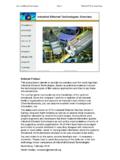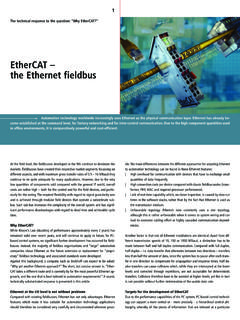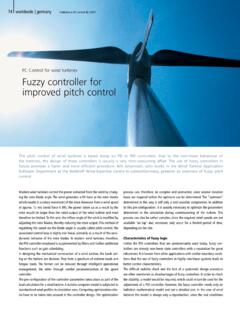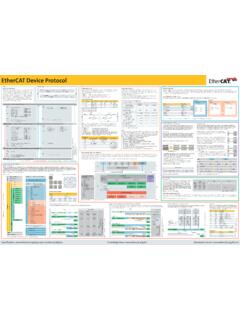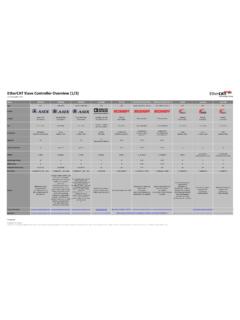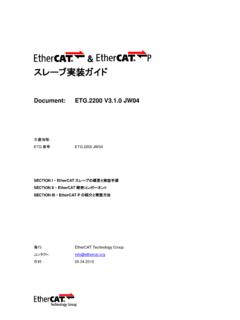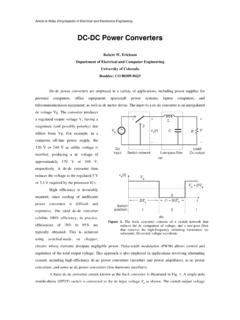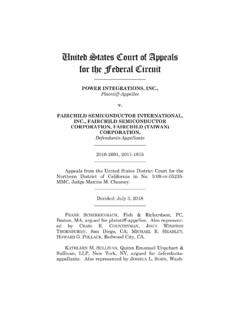Transcription of Ethernet for Semiconductor Equipment 0607
1 High Speed Industrial Ethernet for Semiconductor Equipment Martin Rostan EtherCAT Technology Group Ostendstr. 196, 90482 Nuremberg, Germany Presented at the SEMI Technology Symposium: Innovations in Semiconductor Manufacturing (STS:ISM) on Monday, July 12, 2004, in San Francisco, CA Updated: July 2006 SEMICON West 2004 (update: 7/2006) SEMI Technical Symposium: Innovations in Semiconductor Manufacturing (STS: ISM) ISBN # 1-892568-79-9 2004 SEMI 2004 Semiconductor Equipment and Materials International Abstract A real time industrial Ethernet technology is shown, which overcomes the limitations of existing and upcoming solutions.
2 It is shown that this technology named EtherCAT ( Ethernet for Control Automation Technology) sets new standards for real-time performance since it communicates the data of 1000 distributed I/Os in 30 s using standard twisted pair cable. The system allows one to combine line, tree and star topology, works with and without switches and thus leads to significantly reduced infrastructure costs. Ethernet and internet technologies are made available down to the electronic terminal level. As the entire protocol is implemented in hardware, the system performance is independent of the slaves processing power and is suitable for masters that have little processing power available for field bus communication purposes.
3 It is shown that this Ethernet technology fulfils the requirements of next generation Semiconductor manufacturing Equipment whilst preserving existing standards and investments where appropriate. EtherCAT is an open technology, standardized by IEC and ISO and supported by an international user and vendor organization. SEMI standardization has also been initiated (7/06). Introduction Semiconductor Equipment controls is characterized by a large variety of different controllers, operating systems, communication networks and interfaces. All control solutions have in common that they have to provide for additional components.
4 There are two ways to integrate those: devices for which moderate communication performance is sufficient can be connected via fieldbus systems. Devices that have more demanding communication requirements with the controller such as extremely short reaction times or maximum data throughput have to be connected via a parallel backplane bus system. Examples for such backplane bus devices are fieldbus interface cards, high-speed I/O or motion control cards. For an increasing share of control applications Ethernet connectivity is demanded or at least desirable. Used for uplink purposes, this interface enables integration in plant wide networks and remote diagnosis capabilities.
5 And as the Ethernet technology furthermore promises low costs, ease of use and good performance, Ethernet is currently being introduced at the fieldbus level too. However, Ethernet was developed for moving large data units and due to the minimum frame length has a huge overhead when transporting only a few bytes of data, thus leading to poor bandwidth usage (Fig 1.). Therefore in spite of using Ethernet with 100 MBaud data rate, most industrial Ethernet approaches provide a fieldbus performance similar to the existing fieldbus systems. Thus they can only replace the fieldbus system, but not the backplane bus of a control system.
6 Figure 1: Poor bandwidth usage, poor performance EtherCAT is an Ethernet technology that fully utilizes the bandwidth of full duplex 100 MBaud Ethernet . The resulting performance is outstanding and allows one to replace the backplane bus by EtherCAT as well. This leads to physically smaller controllers without expansion slots and with significantly smaller footprints, thus saving space and the related costs (Fig 2.) Figure 2: Use of EtherCAT leads to smaller controllers As EtherCAT master devices use standard Ethernet Medium Access Controllers (MACs) without extra communication processors, EtherCAT can be implemented on any Equipment controller that provides an Ethernet interface, independently of the operating system or application environment.
7 And as backplane bus devices can be placed externally, additional interfaces such as fieldbus scanner cards or motion control devices can be added without being limited by the number of available slots in the controller. Introduction of EtherCAT technology does not necessarily mean changing the controller technology, and well established fieldbus systems can still be used in conjunction with EtherCAT. In the following sections the EtherCAT Technology is explained in some detail. Operating principle From an Ethernet point of view, an EtherCAT bus segment is simply a single large Ethernet device.
8 This SEMICON West 2004 (update: 7/2006) SEMI Technical Symposium: Innovations in Semiconductor Manufacturing (STS: ISM) ISBN # 1-892568-79-9 2004 SEMI 2004 Semiconductor Equipment and Materials International device receives and sends Ethernet telegrams. However, the device does not contain an Ethernet controller with downstream microprocessor, but a large number of EtherCAT slaves. These process the incoming frames directly and extract the relevant user data, and/or they insert data and transfer the frame to the next EtherCAT slave.
9 The last EtherCAT slave sends the fully processed frame back, so that it is returned by the first slave to the control as a kind of response telegram. This procedure utilizes the fact that Ethernet deals separately with transfers in separate directions (Tx- and Rx-lines) and operates in full duplex mode: the transmitted frames are returned to the control by loop-back through the Rx-wire pair. Naturally, like for any other Ethernet device, direct communication without switch may be established, thereby creating a pure EtherCAT system in direct mode. Telegram processing Telegrams are processed directly on the fly.
10 While the frames (delayed by only a few bit times) are already passed on, the slave controller recognizes relevant commands and executes them accordingly. Processing is done within the hardware and is therefore independent of the response times of any microprocessors that may be connected. Each device has an addressable memory of up to 64 kB that can be read or written, either consecutively or simultaneously. Several EtherCAT datagrams can be embedded within an Ethernet frame, each addressing individual devices and/or memory areas.
